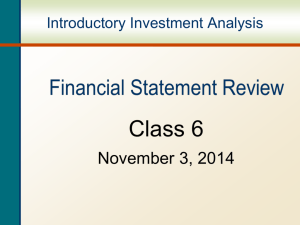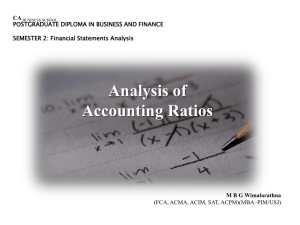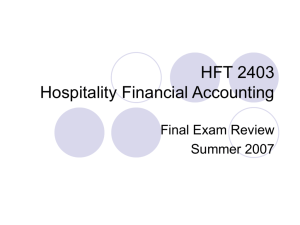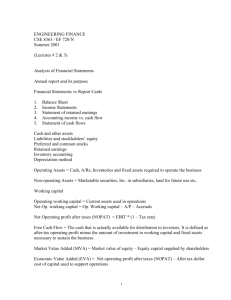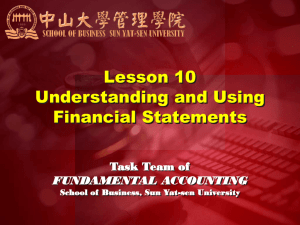Intro Inv Anal Feb 2 slide set 02 BW
advertisement
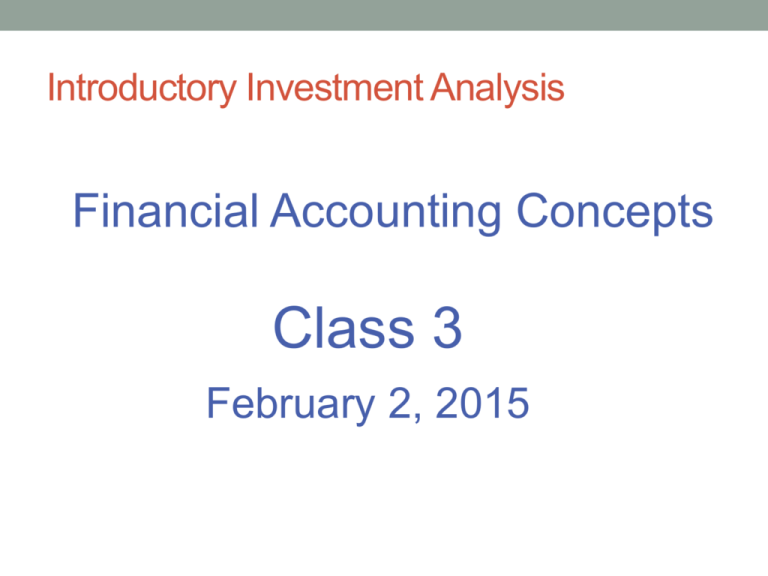
Introductory Investment Analysis Financial Accounting Concepts Class 3 February 2, 2015 17-1 Earnings and Cash Flow Analysis • The goal of this segment is to show you the financial accounting concepts necessary to: • Understand basic financial statements, and • Perform earnings and cash flow analysis using basic financial statements. • Keep in mind: Cash flow is a company’s lifeblood. Sample Balance Sheet Numbers in millions 2003 2002 2003 2002 Cash 696 58 A/P 307 303 A/R 956 992 N/P 26 119 Inventory 301 361 Other CL 1,662 1,353 Other CA 303 264 Total CL 1,995 1,775 Total CA 2,256 1,675 LT Debt 843 1,091 Net FA 3,138 3,358 C/S 2,556 2,167 Total Assets 5,394 5,033 Total Liab. & Equity 5,394 5,033 2 Sample Income Statement Numbers in millions, except EPS & DPS Revenues 5,000 Cost of Goods Sold 2,006 Expenses 1,740 Depreciation 116 EBIT 1,138 Interest Expense 7 Taxable Income Taxes 1,131 442 Net Income 689 EPS 3.61 Dividends per share 1.08 3 4 Sources and Uses • Sources • Cash inflow – occurs when we “sell” something • Decrease in asset account • Accounts receivable, inventory, and net fixed assets • Increase in liability or equity account • Accounts payable, other current liabilities, and common stock • Uses • Cash outflow – occurs when we “buy” something • Increase in asset account • Cash and other current assets • Decrease in liability or equity account • Notes payable and long-term debt 5 Statement of Cash Flows • Statement that summarizes the sources and uses of cash • Changes divided into three major categories • Operating Activity – • • includes net income and changes in most current accounts Investment Activity – includes changes in fixed assets Financing Activity – includes changes in notes payable, long-term debt and equity accounts as well as dividends 6 Sample Statement of Cash Flows Numbers in millions Cash, beginning of year 58 Operating Activity Financing Activity Decrease in Notes Payable Net Income 689 Decrease in LT Debt Plus: Depreciation 116 Decrease in C/S (minus RE) Decrease in A/R 36 Decrease in Inventory 60 Increase in A/P Increase in Other CL Less: Increase in CA Net Cash from Operations 4 309 -39 1,175 Investment Activity Sale of Fixed Assets Net Cash from Investments 104 104 Dividends Paid Net Cash from Financing -93 -248 -94 -206 -641 Net Increase in Cash 638 Cash End of Year 696 7 Standardized Financial Statements • Common-Size Balance Sheets • Compute all accounts as a percent of total assets • Common-Size Income Statements • Compute all line items as a percent of sales • Standardized statements make it easier to compare financial information, particularly as the company grows • They are also useful for comparing companies of different sizes, particularly within the same industry 8 Ratio Analysis • Ratios also allow for better comparison through time or between companies • As we look at each ratio, ask yourself what the ratio is trying to measure and why is that information is important • Ratios are used both internally and externally 9 Categories of Financial Ratios • Short-term solvency or liquidity ratios • Long-term solvency or financial leverage ratios • Asset management or turnover ratios • Profitability ratios • Market value ratios 10 Computing Liquidity Ratios • Current Ratio = CA / CL • 2256 / 1995 = 1.13 times • Quick Ratio = (CA – Inventory) / CL • (2256 – 1995) / 1995 = .1308 times • Cash Ratio = Cash / CL • 696 / 1995 = .35 times • NWC to Total Assets = NWC / TA • (2256 – 1995) / 5394 = .05 • Interval Measure = CA / average daily operating costs • 2256 / ((2006 + 1740)/365) = 219.8 days 11 Computing Long-term Solvency Ratios • Total Debt Ratio = (TA – TE) / TA • (5394 – 2556) / 5394 = 52.61% • Debt/Equity = TD / TE • (5394 – 2556) / 2556 = 1.11 times • Equity Multiplier = TA / TE = 1 + D/E • 1 + 1.11 = 2.11 • Long-term debt ratio = LTD / (LTD + TE) • 843 / (843 + 2556) = 24.80% 12 Computing Coverage Ratios • Times Interest Earned = EBIT / Interest • 1138 / 7 = 162.57 times • Cash Coverage = (EBIT + Depreciation) / Interest • (1138 + 116) / 7 = 179.14 times 13 Computing Inventory Ratios • Inventory Turnover = Cost of Goods Sold / Inventory • 2006 / 301 = 6.66 times • Days’ Sales in Inventory = 365 / Inventory Turnover • 365 / 6.66 = 55 days 14 Computing Receivables Ratios • Receivables Turnover = Sales / Accounts Receivable • 5000 / 956 = 5.23 times • Days’ Sales in Receivables = 365 / Receivables Turnover • 365 / 5.23 = 70 days 15 Computing Total Asset Turnover • Total Asset Turnover = Sales / Total Assets • 5000 / 5394 = .93 • It is not unusual for TAT < 1, especially if a firm has a large amount of fixed assets • NWC Turnover = Sales / NWC • 5000 / (2256 – 1995) = 19.16 times • Fixed Asset Turnover = Sales / NFA • 5000 / 3138 = 1.59 times 16 Computing Profitability Measures • Profit Margin = Net Income / Sales • 689 / 5000 = 13.78% • Return on Assets (ROA) = Net Income / Total Assets • 689 / 5394 = 12.77% • Return on Equity (ROE) = Net Income / Total Equity • 689 / 2556 = 26.96% 17 Computing Market Value Measures • Market Price = $87.65 per share • Shares outstanding = 190.9 million • PE Ratio = Price per share / Earnings per share • 87.65 / 3.61 = 24.28 times • Market-to-book ratio = market value per share / book value per share • 87.65 / (2556 / 190.9) = 6.56 times 18 The DuPont Identity (1) The DuPont Identity = Relationship of ROI and ROE: ROI: Return on Investment (sometimes called ROA-return on assets): Initially compares income as a percentage of total investment, a basic measure of profitability ROI = Net Income Total Assets The DuPont model divides this into two factors: profit margin & asset turnover, illustrating both profitability of operations (profit margin) and efficient use of assets (turnover) ROI = Net Income Sales ROI = (Profit margin) x Sales Total Assets x (Asset Turnover) 19 The DuPont Identity (2) Return on Equity = basic measure of profitability on assets actually provided by owners of a firm: Net Income ROE = Owner’s Equity The DuPont identity combines ROI & ROE into a three part analysis: ROE = Net Income Sales Or ROE = x Sales Total Assets Return on Investment x Total Assets Owner’s Equity x Equity Multiplier Or ROE = Profit Margin x Asset Turnover x Equity Multiplier 20 The DuPont Identity (3) Putting it all together gives the DuPont identity: ROE = ROA x Equity multiplier = Profit margin x Total asset turnover x Equity multiplier Profitability (or the lack thereof!) thus has three parts: • Operating efficiency (profit margin) • Asset use efficiency (asset turnover) • Financial leverage (equity multiplier) 21 The DuPont Identity (4) • To survive at all, the firm must be effective in its use of revenues to generate profits (operating efficiency--profit margin) • To generate profitability, the firm must utilize its investment in assets wisely to convert revenues to profit (asset turnoverefficiency) • But if a firm can generate a return on assets greater than its net borrowing costs, it can return profits to investors more effectively by financial leverage—using borrowed money to generate profits rather than tying up owners’ funds (equity multiplier) 22 Expanded DuPont Analysis – Aeropostale Data • Balance Sheet Data • Cash = 138,356 • Inventory = 61,807 • Other CA = 12,284 • Fixed Assets = 94,601 • EM = 1.654 • Income Statement Data • Sales = 734,868 • COGS = 505,152 • SG&A = 141,520 • Interest = (760) • Taxes = 34,702 • Computations • TA = 307,048 • TAT = 2.393 (total asset turnover) • Computations • NI = 54,254 • PM = 7.383% • ROA = 17.668% • ROE = 29.223% 23 Aeropostale Extended DuPont Chart ROE = 29.223% ROA = 17.668% PM = 7.383% NI = 54,254 Total Costs = - 680,614 COGS = 505,152 Interest = - (760) + x Sales = 734,868 Sales = 734,868 SG&A = - 141,520 Taxes = - 34,702 x EM = 1.654 TAT = 2.393 Sales = 734,868 Fixed Assets = 94,601 TA = 307,048 + Current Assets = 212,447 Cash = 138,356 Other CA = 12,284 Inventory = 61,807 24 Benchmarking • Ratios are not very helpful by themselves; they need to be compared to something • Time-Trend Analysis • Used to see how the firm’s performance is changing through time • Internal and external uses • Peer Group Analysis • Compare to similar companies or within industries • SIC and NAICS codes 25 Potential Problems • There is no underlying theory, so there is no way to know which ratios are most relevant • Benchmarking is difficult for diversified firms • Globalization and international competition makes comparison more difficult because of differences in accounting regulations • Varying accounting procedures, i.e. FIFO vs. LIFO • Different fiscal years • Extraordinary events

